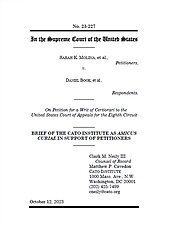The Petitioners sued under Section 1983, claiming that the police retaliated against them for exercising their First Amendment rights. The Eighth Circuit granted the defendants qualified immunity for their actions against Ms. Molina and Ms. Vogel.
Cato filed an amicus brief asking the Supreme Court to reverse that decision and abolish qualified immunity. Neither Section 1983’s text nor the early history of constitutional torts justifies qualified immunity. In fact, courts have wrongly overlooked the fact that Section 1983—as originally enacted by Congress—forecloses qualified immunity. What is more, qualified immunity undermines public confidence in officials, including law enforcement and the courts, and is based on faulty assumptions about how official liability actually works. The mere fact that Congress has not done away with qualified immunity is no reason for the Court to maintain it as a bar to relief for Americans whose rights are violated. The Supreme Court should do away it.


